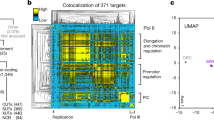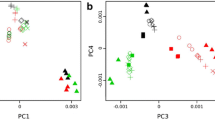Abstract
We have used oligonucleotide tiling arrays to construct genome-wide high-resolution histone acetylation maps for fission yeast. The maps are corrected for nucleosome density and reveal surprisingly uniform patterns of modifications for five different histone acetylation sites. We found that histone acetylation and methylation patterns are generally polar, i.e. they change as a function of distance from the ATG codon. A typical fission yeast gene shows a distinct peak of histone acetylation around the ATG and gradually decreased acetylation levels in the coding region. The patterns are independent of gene length but dependent on the gene expression levels. H3K9Ac shows a stronger peak near the ATG and is more reduced in the coding regions of genes with high expression compared with genes with low expression levels. H4K16Ac is strongly reduced in coding regions of highly expressed genes. A second microarray platform was used to confirm the 5′ to 3′ polarity effects observed with tiling microarrays. By comparing coding region histone acetylation data in HDAC mutants and wild type, we found that hos2 affects primarily the 5′ regions, sir2 and clr6 affect middle regions, and clr6 affects 3′ regions. Thus, mechanisms involving different HDACs modulate histone acetylation levels to maintain a 5′ to 3′ polarity within the coding regions.





Similar content being viewed by others
References
Bernstein BE, Humphrey EL, Erlich RL et al. (2002) Methylation of histone H3 Lys 4 in coding regions of active genes. Proc Natl Acad Sci USA 99: 8695–8700.
Bernstein BE, Liu CL, Humphrey EL, Perlstein EO, Schreiber SL et al. (2004) Global nucleosome occupancy in yeast. Genome Biol 5: R62.
Bernstein BE, Kamal M, Lindblad-Toh K et al. (2005) Genomic maps and comparative analysis of histone modifications in human and mouse. Cell 120: 169–181.
Briggs SD, Bryk M, Strahl BD et al. (2001) Histone H3 lysine 4 methylation is mediated by Set1 and required for cell growth and rDNA silencing in Saccharomyces cerevisiae. Genes Dev 15: 3286–3295.
Cam HP, Sugiyama T, Chen ES et al. (2005) Comprehensive analysis of heterochromatin- and RNAi-mediated epigenetic control of the fission yeast genome. Nat Genet 37: 809–819.
Dion MF, Altschuler SJ, Wu LF, Rando OJ (2005) Genomic characterization reveals a simple histone H4 acetylation code. Proc Natl Acad Sci USA 102: 5501–5506.
Ekwall K (2005) Genome-wide analysis of HDAC function. Trends Genet 21: 608–615.
Gill G (2004) SUMO and ubiquitin in the nucleus: different functions, similar mechanisms? Genes Dev 18: 2046–2059.
Hecht A, Laroche T, Strahl-Bolsinger S, Gasser SM, Grunstein M (1995) Histone H3 and H4 N-termini interact with SIR3 and SIR4 proteins: a molecular model for the formation of heterochromatin in yeast. Cell 80: 583–592.
Iizuka M, Smith MM (2003) Functional consequences of histone modifications. Curr Opin Genet Dev 13: 154–160.
Jenuwein T, Allis CD (2001) Translating the histone code. Science 293: 1074–1080.
John S, Howe L, Tafrov ST et al. (2000) The something about silencing protein, Sas3, is the catalytic subunit of NuA3, a yTAF(II)30-containing HAT complex that interacts with the Spt16 subunit of the yeast CP (Cdc68/Pob3)-FACT complex. Genes Dev 14: 1196–1208.
Kristjuhan A, Walker J, Suka N et al. (2002) Transcriptional inhibition of genes with severe histone H3 hypoacetylation in the coding region. Mol Cell 10: 925–933.
Krogan NJ, Dover J, Wood A et al. (2003) The Paf1 complex is required for histone H3 methylation by COMPASS and Dot1p: linking transcriptional elongation to histone methylation. Mol Cell 11: 721–729.
Kurdistani SK, Grunstein M (2003) Histone acetylation and deacetylation in yeast. Nat Rev Mol Cell Biol 4: 276–284.
Kurdistani SK, Robyr D, Tavazoie S, Grunstein M (2002) Genome-wide binding map of the histone deacetylase Rpd3 in yeast. Nat Genet 31: 248–254.
Kurdistani SK, Tavazoie S, Grunstein M (2004) Mapping global histone acetylation patterns to gene expression. Cell 117: 721–733.
Lee CK, Shibata Y, Rao B, Strahl BD, Lieb JD (2004) Evidence for nucleosome depletion at active regulatory regions genome-wide. Nat Genet 36: 900–905.
Lengronne A, Katou Y, Mori S et al. (2004) Cohesin relocation from sites of chromosomal loading to places of convergent transcription. Nature 430: 573–578.
Liang G, Lin Jc, Wei V et al. (2004) Distinct localization of histone H3 acetylation and H3-K4 methylation to the transcription start sites in the human genome. Proc Natl Acad Sci USA 101: 7357–7362.
Luger K, Mader AW, Richmond RK, Sargent DF, Richmond TJ (1997) Crystal structure of the nucleosome core particle at 2.8 Å resolution. Nature 389: 251–260.
Matangkasombut O, Buratowski S (2003) Different sensitivities of bromodomain factors 1 and 2 to histone H4 acetylation. Mol Cell 11: 353–363.
Mizzen CA, Yang XJ, Kokubo T et al. (1996) The TAF(II)250 subunit of TFIID has histone acetyltransferase activity. Cell 87: 1261–1270.
Ng HH, Robert F, Young RA, Struhl K (2003) Targeted recruitment of Set1 histone methylase by elongating Pol II provides a localized mark and memory of recent transcriptional activity. Mol Cell 11: 709–719.
Perez-Martin J, Johnson AD (1998) Mutations in chromatin components suppress a defect of Gcn5 protein in Saccharomyces cerevisiae. Mol Cell Biol 18: 1049–1054.
Pokholok DK, Harbison CT, Levine S et al. (2005) Genome-wide Map of Nucleosome Acetylation and Methylation in Yeast. Cell 122: 517–527.
Robyr D, Grunstein M (2003) Genomewide histone acetylation microarrays. Methods 31: 83–89.
Robyr D, Suka Y, Xenarios I et al. (2002) Microarray deacetylation maps determine genome-wide functions for yeast histone deacetylases. Cell 109: 437–446.
Rundlett SE, Carmen AA, Kobayashi R et al. (1996) HDA1 and RPD3 are members of distinct yeast histone deacetylase complexes that regulate silencing and transcription. Proc Natl Acad Sci USA 93: 14503–14508.
Santos-Rosa H, Schneider R, Bannister AJ et al. (2002) Active genes are tri-methylated at K4 of histone H3. Nature 419: 407–411.
Sims RJ, Belotserkovskaya R, Reinberg D (2004) Elongation by RNA polymerase II: the short and long of it. Genes Dev 18: 2437–2468.
Suka N, Suka Y, Carmen AA, Wu J, Grunstein M (2001) Highly specific antibodies determine histone acetylation site usage in yeast heterochromatin and euchromatin. Mol Cell 8: 473–479.
Taunton J, Hassig CA, Schreiber Sl (1996) A mammalian histone deacetylase related to the yeast transcriptional regulator Rpd3p. Science 272: 408–411.
Turner BM (1993) Decoding the nucleosome. Cell 75: 5–8.
Wade PA, Pruss D, Wolffe AP (1997) Histone acetylation: chromatin in action. Trends Biochem Sci 22: 128–132.
Wang A, Kurdistani SK, Grunstein M (2002) Requirement of Hos2 histone deacetylase for gene activity in yeast. Science 298: 1412–1414.
Winkler GS, Kristjuhan A, Erdjument-Bromage H, Tempst P, Svejstrup JQ (2002) Elongator is a histone H3 and H4 acetyltransferase important for normal histone acetylation levels in vivo. Proc Natl Acad Sci USA 99: 3517–3522.
Wirbelauer C, Bell O, Schubeler D (2005) Variant histone H3.3 is deposited at sites of nucleosomal displacement throughout transcribed genes while active histone modifications show a promoter-proximal bias. Genes Dev 19: 1761–1766.
Wirén M, Silverstein RA, Sinha I et al. (2005) Genome-wide analysis of nucleosome density histone acetylation and HDAC function in fission yeast. EMBO J 24: 2906–2918.
Xue Y, Haas SA, Brino L et al. (2004) A DNA microarray for fission yeast: minimal changes in global gene expression after temperature shift. Yeast 21: 25–39.
Acknowledgements
K.E. is a Royal Swedish Academy of Sciences Research Fellow supported by grants from Knut and Alice Wallenberg Foundation, Swedish Cancer Society, Swedish Research Council (VR), and the EU ‘Epigenome’ network of excellence. We thank Michael Grunstein (UCLA) for kindly providing antibodies against acetylated histones and David Allis (Rockefeller) for kindly providing the H3K9Me2 antibody. We thank Carolina Bonilla (University College Sodertorn) and Marika Rönnholm (KI, Dept. Biosciences Novum) for their kind help with microarray experiments. We also thank all group members, in particular Rebecca Silverstein, for critical reading of the manuscript.
Author information
Authors and Affiliations
Corresponding author
Electronic Supplementary material
DO00001023_ESM.pdf
The figure represents the basic definitions based on gene orientation used to develop a new nomenclature for S. pombe microarray tiling fragments.
Rights and permissions
About this article
Cite this article
Sinha, I., Wirén, M. & Ekwall, K. Genome-wide patterns of histone modifications in fission yeast. Chromosome Res 14, 95–105 (2006). https://doi.org/10.1007/s10577-005-1023-4
Published:
Issue Date:
DOI: https://doi.org/10.1007/s10577-005-1023-4




